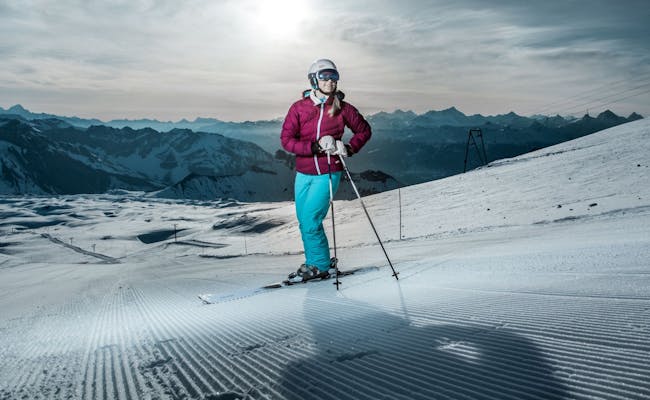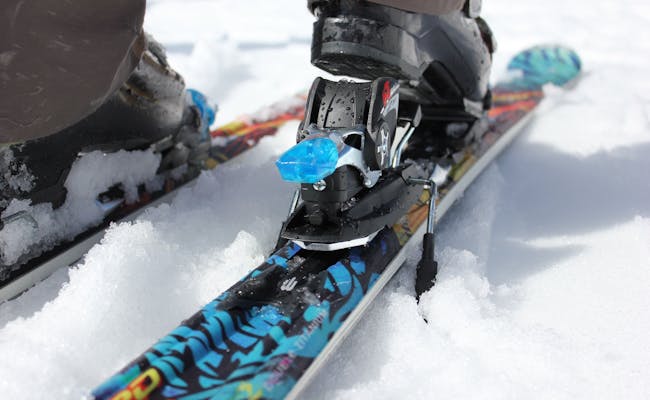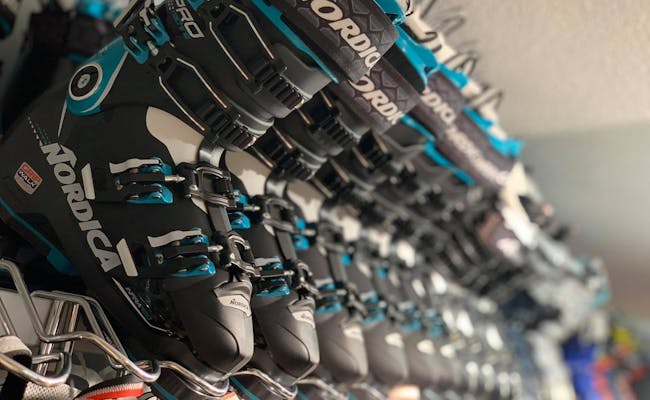You are planning a winter vacation in Switzerland, but don't want to buy ski equipment or carry your own? No problem, because there are now enough providers in every ski resort in Switzerland. So you can rent skis of all models and price ranges. Whether it's alpine skiing, Nordic skiing or snowboards, it doesn't matter.
But how do you find the best ski equipment that suits you and your skiing skills? And what else is there to consider when renting skis?
 (Foto: Destination Davos Klosters Matthias Paintner)
(Foto: Destination Davos Klosters Matthias Paintner) Ski mieten in der Schweiz (Foto: Glacier 3000)
Ski mieten in der Schweiz (Foto: Glacier 3000)Guidelines for ski rental
Roughly speaking, the shorter the skis, the easier they are to ski. So it matters whether you have previous experience or are new to skiing.
Ski rental for beginners
When renting skis for beginners, All Mountain Ski or Allround Carver/Easy Carver are recommended, which reach up to the chest or shoulder. Ski lengths below the chest are not recommended for beginners and novices, because otherwise the stability is too low. The skis should also be soft in structure. Suitable slopes for beginners are marked with the colors blue and red.
Ski rental for advanced skiers
Experienced and advanced skiers should choose All Mountain Ski or Allround Carver/Easy Carver when renting skis. These should reach either to the shoulder, chin or tip of the nose. The recommended material of the skis is soft to medium. The ideal slopes for experienced and advanced skiers are also the blue and red runs.
Ski rental for experienced and professional skiers
Experienced skiers, sporty ski pros and racers go for All Mountain Ski, Allround Carver, Freeride Ski or Race Carver These reach up to the tip of the nose or even the crown of the head. Unless you have a slalom descent planned. Then you should rent shorter skis with chin length, for giant slalom again with crown length. The construction of skis for professionals is hard and the ideal slopes are marked red and black. Since sporty professionals have enough endurance, strength, technique and condition anyway, they can freely choose between any ski lengths.
Ski length recommendation
| Height (cm) | Ski length (cm) |
|---|---|
| 160 | 150 |
| 170 | 160 |
| 180 | 165 |
| 190 | 165 |
| 200 | 170 |
These values are only rough guidelines. In order to find the perfect equipment when renting skis, weight, age and gender are also decisive. Another factor for your safety on two boards is the waist and the radius of the skis. The waist is the width of the ski below the binding. The stronger the waist, the smaller the radius you can ski. A 14 m radius also allows you to make tighter turns. An 18 m radius, on the other hand, allows you to make larger turns.
 Finde deinen passende Ski für die perfekte Abfahrt.
Finde deinen passende Ski für die perfekte Abfahrt. Im Skiverleih wirst du professionell beraten (Foto: Titlis Rent)
Im Skiverleih wirst du professionell beraten (Foto: Titlis Rent)The snow conditions are also a decisive factor for the length of the skis. If you ski in Switzerland between December and February, the snow is usually harder and sometimes even icy. With longer snowboards you will find the right stability in these conditions. In April and May, when the spring sun softens the snow masses, you should choose shorter skis. In the soft firn snow you will then ski with less effort.
The guidelines that help you rent skis also apply to renting a snowboard. It is advisable to consult an expert on the spot to help you make the right choice.
How big should the ski poles be when renting skis?
When renting skis in Switzerland, the ski poles are also a decisive factor for safe skiing on the slopes. Similar to the skis, the choice of poles depends on the local conditions and your own preferences
Ski racers in giant slalom can support themselves better with longer poles both at the start and in the turns. Freeriders on humpy slopes, on the other hand, enjoy more fun with shorter poles. So those who want to go fast and therefore often push themselves with their arms choose longer ski poles
More and more popular are the so-called telescopic poles, which can be individually adjusted to the respective conditions. These are also popular with tourers and freeriders.
Again, when choosing the right ski poles, your height, but also your leg length, skiing ability and personal preference are crucial. Although there is a simple formula that you can use to calculate the optimal length of ski poles. This is: body size in cm x 0.7 = length of the ski pole in cm
The following table can also help you
Ski pole length recommendation
| body height (cm) | ski pole length (cm) |
|---|---|
| 155 to 161 | 110 |
| 162 to 168 | 115 |
| 169 to 175 | 120 |
| 176 to 182 | 125 |
| 183 to 189 | 130 |
| 190 to 196 | 135 |
| over 196 | 140 |
Freeriders can subtract another 5 cm from these recommendations. In a snow park, even rather only the 1-meter ski poles belong to the standard equipment.
There is a simple practical test for the right choice of ski poles. To do this, you should already be wearing your ski equipment, including skis and boots. Turn the ski pole around so that the handle touches the ground. Then take the pole in your hand below the round plate. The part above the plate sinks into the snow anyway and is therefore not counted for the optimal length of the ski poles
If your arm then forms an uncomplicated right angle, you have found the ideal ski poles. Try shorter and longer poles, then you will immediately feel the difference.
Good ski poles also have an ergonomic grip. The material should be light and strong at the same time - mostly aluminum is used. Professionals ski with the harder carbon ski poles and with telescopic ski poles made of Titanal. These allow quick adjustment of the length even in cold temperatures.
 Die passende Länge der Skistöcke ist wichtig (Foto: Glacier 3000)
Die passende Länge der Skistöcke ist wichtig (Foto: Glacier 3000) Perfekt ausgerüstet auf die Piste (Foto: Titlis Rent)
Perfekt ausgerüstet auf die Piste (Foto: Titlis Rent)The right ski binding when renting skis
The ski binding is an essential safety factor. Of course, you can also adjust your binding yourself when renting skis. However, we advise you to leave this part to the professionals from the ski rental.
The professionals have a standardized testing device with which they can test when the ski binding releases. The decisive factor here is the so-called Z-value, which states the force with which the binding must be acted upon in order for it to release the boot. This is important because in the event of a fall, the risk of injury is lower if the ski boot releases in time.
In return, the ski boot must not be clamped too loosely so that the ski binding does not give up already in a sharp turn. So the higher this Z-value is, the later the ski binding releases the ski boot. The Z-value is in turn adjusted to your age, weight, gender, height, also sole length, contact pressure (= the force by which the boot is pressed into the binding) and skiing ability.
 (Foto: Zermatt Tourismus Palcal Gertschen)
(Foto: Zermatt Tourismus Palcal Gertschen) Skifahren in der Schweiz
Skifahren in der SchweizRent the right ski boot
Of course, when renting skis in Switzerland, the right ski boots are also essential. After all, they should be comfortable. Your foot should not slide back and forth in the shoe. Many beginners or hobby skiers make the mistake of buying shoes that are too big
The shoe should not cause pain even after several descents. Midfoot and heel must sit firmly in the ski boot. In the end, your foot decides after a short time of trying on whether the shoe is comfortable or not. Optical aspects should be disregarded. Above all, the ski boot should be comfortable to wear and warm. Therefore, it is advisable to always test several models to find the right shoe
Almost like Rapunzel..
Flex value when renting a ski boot
A good guideline for finding the perfect ski boot for your individual skiing behavior is the so-called flex value. This value, also known as the flex index, indicates how stiff the shell of the ski boot is. The higher the value, the harder the shell
Ski racers pay attention to a high flex value, because a stiff shell allows a higher power transmission and thus a higher speed at the same time. For ski beginners, on the other hand, a low flex value is advantageous, allowing more freedom in the ankle joint. The same applies to the last width, i.e. the widest part of the forefoot. The wider the last, the more comfortable the ski boot. Racers use a narrow last width.
 Finde deinen passenden Skischuh (Foto: Titlis Rent)
Finde deinen passenden Skischuh (Foto: Titlis Rent) Die Auswahl ist gross genug (Foto: Titlis Rent)
Die Auswahl ist gross genug (Foto: Titlis Rent)Moon point when renting ski boots
For the size of the ski boots, the so-called moon point, also called "moon" or "MP", is decisive. This is a boot size system that takes into account not only the size of the feet, but also the width. After determining your foot length from the heel to the tip of the big toe, you add 0.5 mm. This will give you the appropriate moonpoint.
Recommendation for ski boot rental
| Shoe size | Foot length (cm) | Moon point (mm) |
|---|---|---|
| 38 | 24 | 240 |
| 39 | 25 | 250 |
| 40 | 25.35 | 255 |
| 41 | 26 | 260 |
| 42 | 26.70 | 265 |
| 43 | 27.35 | 275 |
| 44 | 28 | 280 |
A simple test while trying on will help you decide which ski boot is best for you. Place your feet shoulder-width apart on the floor, tilt your upper body in all directions without ever letting your heels slide up. If you do not feel any pain, the foot is not too loose. If your feet feel comfortable, you have found the right shoe.
Is ski insurance necessary when renting skis?
When renting skis in Switzerland, employees often recommend having their own ski insurance to cover theft and breakage. However, the opinions of insurance experts vary widely when it comes to this topic Basically, a ski theft directly on the slopes occurs rather rarely and even if you park your skis in front of an alpine hut, hardly anyone will take them. After all, most of the people present are skiing themselves and it is a bit conspicuous when someone is skiing down the slope with two pairs of skis. The number of ski thefts has actually been declining in recent years
Also, the breakage of skis almost never happens, because the material usually withstands falls well. In addition, damage and even theft of skis are often covered by a normal, private liability insurance. If the ski breaks due to material fatigue, the ski rental company is responsible anyway. On average, a fee of 10% of the rental amount is charged for ski insurance at the ski rental shop
If, contrary to expectations, a theft does occur, the rental company can only charge the current value of the skis and not the purchase price. Therefore, when renting skis, it is recommended that the age of the skis is also noted on the contract. You can then report the theft and breakage to your private liability insurance.
Of course, this is only a recommendation and you decide for yourself how big a risk you want to take.
The different ski models
Below we give you a brief overview of the different types of skis that you will encounter in a ski rental in Switzerland.
 Skifahren in Zermatt (Foto: Zermatt Tourismus Palcal Gertschen)
Skifahren in Zermatt (Foto: Zermatt Tourismus Palcal Gertschen) Skifahren am Schilthorn (Foto: Schilthornbahn AG)
Skifahren am Schilthorn (Foto: Schilthornbahn AG)Carving Ski
Basically, any ski that allows you to "carve" turns and curves in the snow is a carving ski. The difference between the individual models is made by the waist of the ski. So there are the almost all mistakes forgiving, not much waisted all-round carvers or easy carvers, which are excellent for beginners and inexperienced. What the more narrowly waisted slalom carvers, sport carvers and race carvers are used for, the name already tells you.
All Mountain Ski
This is the all-rounder among carving skis, suitable for groomed slopes as well as off-piste and deep snow. When choosing an all-mountain ski, you should pay attention to the hardness of the material, because the softer, the more comfortable the ski is to control, and the harder, the better your skiing skills must be.
Freestyle ski or twintip ski
A prodigy among ski models, because the freestyle ski or twintip ski can be skied both forwards and backwards and is therefore mainly intended for professionals. You can recognize these ski models at ski rental in Switzerland by their bent up shovels at both ends. They are not meant for fast descents, but more for snow park adventures.
Freeride Ski
What the Freestyle Ski can't do, the Freeride Ski can, because it can be used in the snowpark as well as on slopes. The wide ski is also suitable for touring in deep snow.
Touring Ski
This type of ski model is very light in terms of material, since the skis often have to be brought up the mountain by strapping them to the back during the ski tour. They also have a special binding that allows going uphill even with the skis strapped and can be fixed at both ends before the descent.
If all values are adjusted, the boot feels comfortable and you have found your suitable ski equipment at the ski rental in Switzerland, nothing stands in the way of pure snow fun in the fantastic ski resorts of Switzerland!
 Miete deine Skiausrüstung und geniesse die Schweizer Skipisten
Miete deine Skiausrüstung und geniesse die Schweizer Skipisten Skifahren in der Schweiz (Foto: Titlis Rent)
Skifahren in der Schweiz (Foto: Titlis Rent)Once all the values are set, the boot feels comfortable and the poles are the right length, you've made it. You have successfully completed your mission "Ski rental in Switzerland". Now nothing stands in the way of pure snow fun in the fantastic ski resorts of Switzerland.
